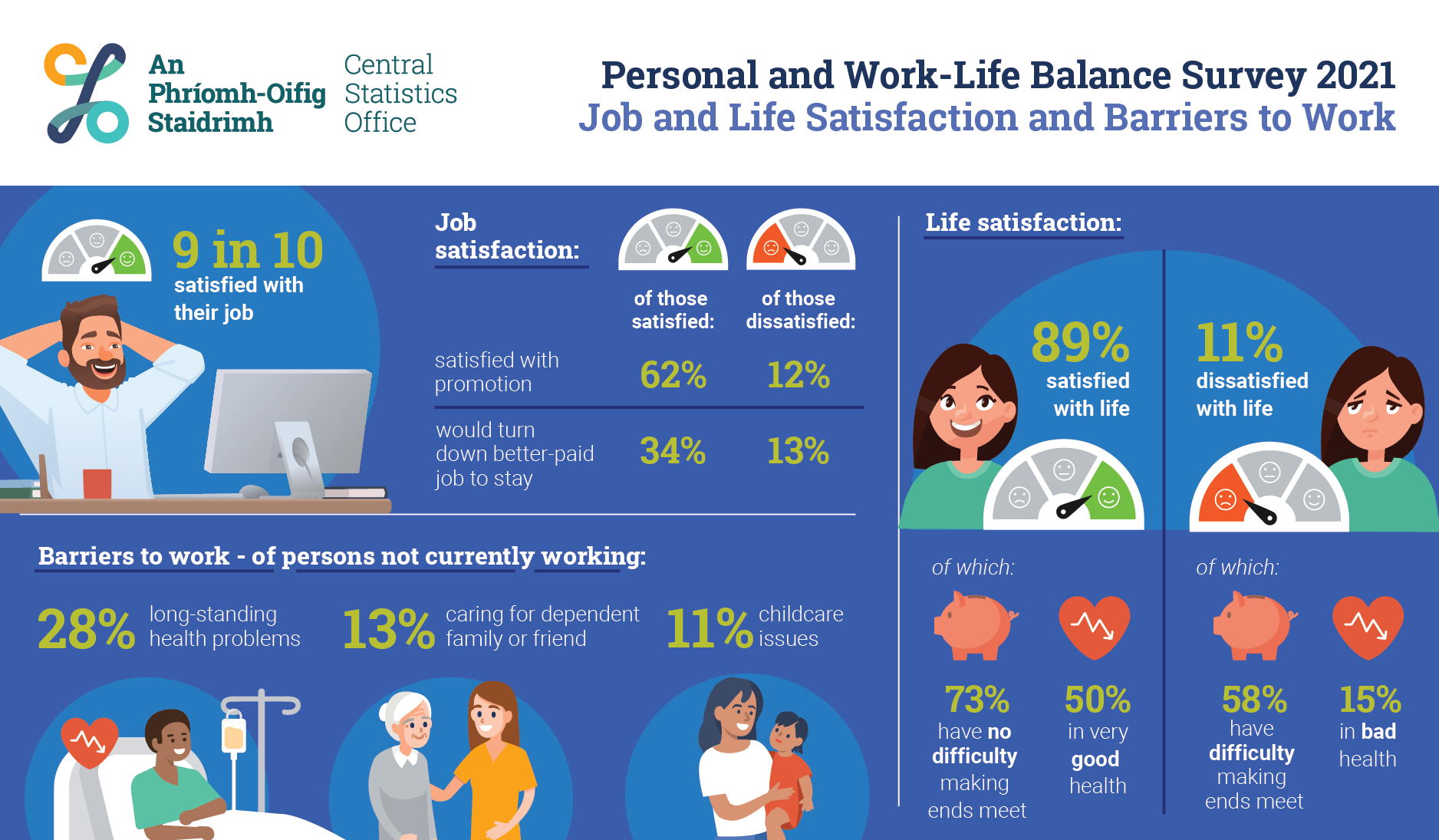The Central Statistics Office (CSO) has published the second of three publications on the results of the Personal and Work-Life Balance Survey which was carried out in Quarter 3, 2021. The detail in this publication is a subset of the broader data collected. The first publication “Personal and Work-Life Balance Survey 2021 – Main Results” was published on 05 April 2022 and the third and final publication “Personal and Work-Life Balance Survey 2021 – Remote Working” will be published on 26 April 2022. This publication on “Job and Life Satisfaction and Barriers to Work” covers life satisfaction and the type of support networks available from family, friends, and community, and job satisfaction and the factors that impact on satisfaction in the workplace. While the survey focussed primarily on persons in employment, it also looked at barriers to work for persons not currently in employment.
Key findings were:
- The majority of persons (89%) aged 18 years and over are satisfied with their life and there is a similar (89%) job satisfaction rating amongst employees
- Of those dissatisfied with their job, work pressures such as having to work long hours or more than their contracted hours, and lack of promotional opportunities impacted job satisfaction
- Employees most likely to leave their job within the next six months are those who are temporary or part-time or are only with their current employer for a short period
- Of those dissatisfied with life, nearly six in ten (58%) found it hard to make ends meet, while almost one in seven (15%) were in poor health
- For persons currently not in employment, the main barrier to return to work was long-standing health problems (28%), followed by caring for dependent family or friends (13%) and childcare issues (11%)
- There were no barriers preventing return to work for over one in five (21%) of those currently not working
Commenting on the report, Maureen Delamere, Statistician, said: “The Personal and Work-Life Balance Survey was carried out in Quarter 3 2021, in the midst of the COVID-19 pandemic. In Quarter 3 2021, there were still varying levels of COVID-19 in the community with related restrictions. The survey largely focusses on employees, including those who may have returned to work following lay-off or temporary lay-off as a result of the virus. It also covers people not currently working, including those who may have been laid off due to COVID-19.

Despite living through more than 18 months of the pandemic and its associated restrictions on our personal and working lives, life and job satisfaction rates remained high amongst the Irish population when the survey was conducted during the months of July, August, and September 2021. Almost nine in ten persons were satisfied or very satisfied with their life as a whole. Our data analysis shows that there are many factors which can influence life satisfaction such as physical health, the ability to make ends meet, support from family, friends, and neighbours, and whether a person is working or not.
The ability to make ends meet impacts significantly on life satisfaction. Nearly six in ten (58%) persons dissatisfied with life struggled to make ends meet, more than double that of those contented with their life (27%). Also, people in poor health were more likely to be dissatisfied with life. Of those who were discontented with life, almost one in six (15%) were in very poor health, compared with just 2% of those who were happy with their life. A further one-third of those dissatisfied with life said their self-perceived health status was only fair. The support that one gets from family, friends and neighbours plays an important role in how satisfied people are with their lives. More than one third (36%) of people who get no support or help from family were dissatisfied with their life, compared with most (93%) of persons who get a lot of support from family and are satisfied with their life.
One’s employment status is a factor. More than nine in ten (92%) persons who were working were contented with life, compared with over four in five (82%) of those who were not in employment. For those in employment, nine in ten (89%) were satisfied or very satisfied with their job. Of those who were dissatisfied with their job, work pressures played their part. While employees who are satisfied with their job also work long hours, more people who were dissatisfied in their job reported working long hours. Nearly nine in ten (88%) workers dissatisfied with their job said they have to work very hard, compared with just short of eight in ten (78%) workers satisfied with their job. Similarly, of employees who were dissatisfied with their job, almost six in ten (59%) never have enough time to get their job done, compared with 44% of workers who are happy in their job. Also, just short of half (49%) of those who have to work more than their contracted hours to get the job done are dissatisfied with their job, compared with four in ten (40%) employees who said that they were satisfied with their job.
Full-time workers with long service were more likely to turn down an offer of a better paid job elsewhere than part-time workers with same service or employees, full and part-time with less service. However, temporary, or part-time employees or those with less service were more likely to leave a job within the next six months, irrespective of any offer of a better job elsewhere. Almost one quarter (24%) of temporary employees said they were likely to leave their job within the next six months, double the likelihood of their permanent equivalents (12%). Part-time workers with a short length of service with their current employer are nearly twice as likely as their full-time equivalents to leave their organisation in the short term – 25% compared with one in seven (14%) full-time employees with less than five years’ service.”
Looking at barriers to employment, Maureen Delamere, further commented: “For persons currently not in employment, the main barrier to returning to work was long-standing health problems (28%), followed by caring for dependent family or friends (13%) and childcare issues (11%). There were no barriers preventing return to the workplace for over one in five (21%) of those currently not working.”


